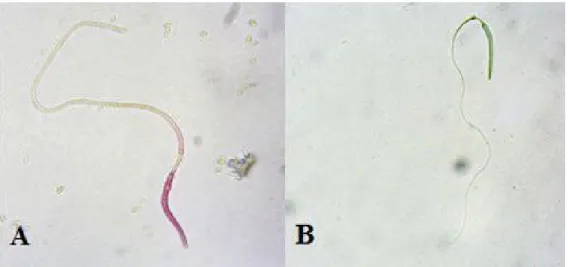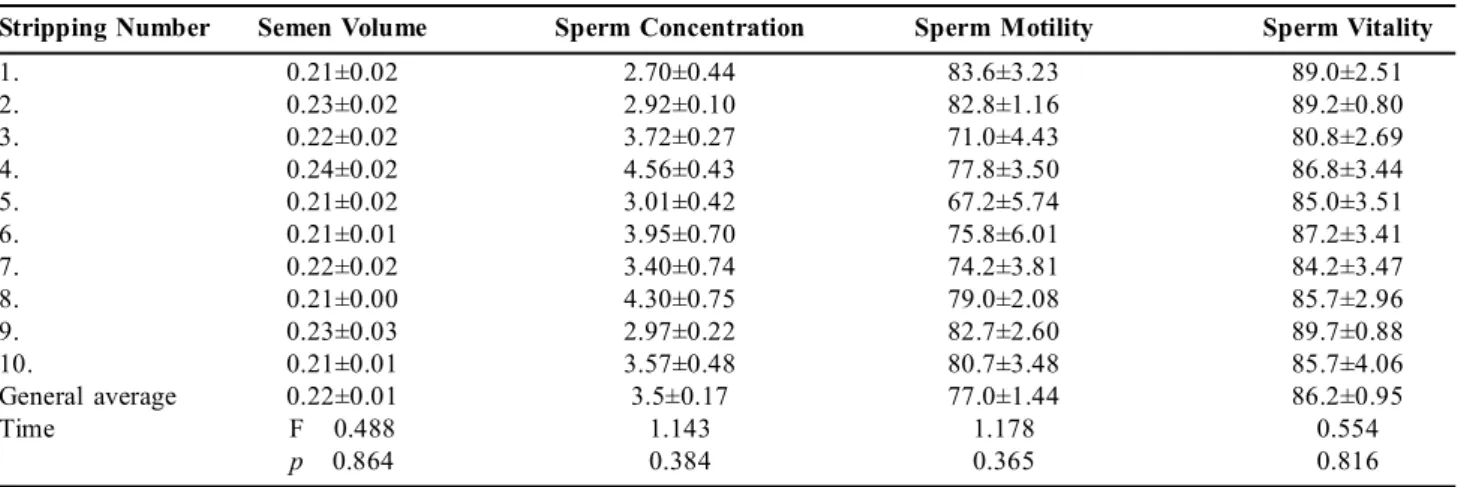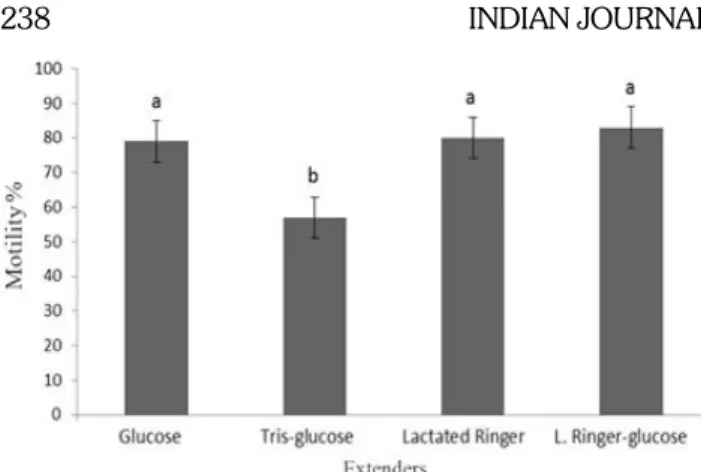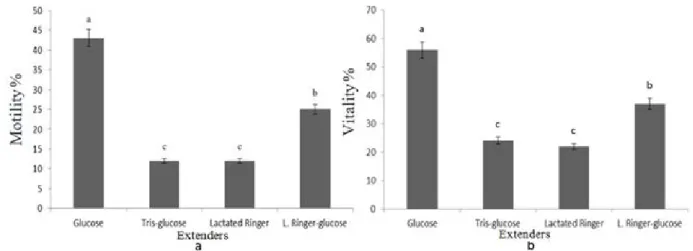www.arccjournals.com/www.ijaronline.in
*Corresponding author’s e-mail: ataskin@ahievran.edu.tr
#This study has produced the first author of the master thesis prepared in consultation with the second author.
The effect of different extenders on the sperm motility
and viability of frozen Turkey semen
#Mehmet Kuzlu and Atilla Taskin*
Department of Animal Science,
Faculty of Agriculture, University of Ahi Evran, 40100, Turkey.
Received: 15-01-2016 Accepted: 26-09-2016 DOI:10.18805/ijar.v0iOF.6825
ABSTRACT
This study was conducted to develop long-term storage methods for turkey semen using different extenders. During the study, the massage method was used twice a week to collect the semen from five turkeys, a total of 44 times. The collected fresh semen’s average ejaculate quantity, sperm concentration, motility and vitality values were determined as 0.22±0.01 ml, 3.5±0.17 x109 sp/ml, 77.0±1.44% and 86.2±0.95 % respectively. In this study, glucose (G) including 5% Dimethyl
sulphoxide (DMSO) cryoprotective, tris-glucose (TG), lactated Ringer’s (LR), and lactated Ringer’s glucose (LRG) extenders were used. The Turkey semen was combined and divided into four equal parts, and subsequently diluted at a ratio of 1:3 and equilibrated at +4°C for 90 minutes. Following equilibration, the samples were frozen in liquid nitrogen vapor to -80°C for five minutes, and stored at -196°C in liquid nitrogen. After freezing and thawing, the highest motility value was obtained from the G extender (43.3% ±1.62%) followed by LRG (24.6±1.53%), LR (12.6±0.92%) and TG (12.2±0.66%). The vitality values were recorded as 55.8±1.89%, 23.8±1.58%, 21.5±1.10% and 36.5±1.59% respectively. The motility and vitality values were significantly (p<0.01) more for the glucose extender than those for other extenders. Therefore, it was concluded that glucose extender is better option for the long-term storage of Turkey semen.
Key words: Cryopreservation, Motility, Sperm, Turkey, Vitality. INTRODUCTION
Sperm cryopreservation is made for the purpose of protecting species, clinical studies and developing assisted reproduction techniques, such as artificial insemination (AI), embryo transfer and in vitro fertilization (Medeiros et al., 2002). Turkey semen should be protected for a long time in order to effectively use in AI studies. The ratio for Turkey semen collected using the massage method is higher than during natural breeding. For a short period, by diluting the semen with physiological extenders, it can be used for the purpose of AI (Akcay et al., 1997). Measurements, such as ejaculate ratio, motility, vitality, abnormal defects, pH, and semen concentration should be made to determine semen quality (Alkan et al., 2002).
Poultry semen has a very low resistance to the inner development of ice crystals. One of the most sensitive points of a good freezing curve is the transfer between temperatures, and these transfers are applied by freezing semen at a slow speed. Faster freezing is mostly applied to fish and mammals becausse this technique have little cellular damaging affects (Seigneurin and Blesbois, 1995). Different procedures may be required for certain species of poultry and these procedures can be differentiated in terms of certain factors, such as suitable timing, cooling, equalizing temperature,
diluter and cryoprotectant suitability (Lukaszewicz, 2001; Blesbois, 2007; Graham, 2007).
It is recommended that cryoprotectants with impermeable characteristics are used (Massip, 2001; Tarvis, 2013) to decrease crystallization in cellular water. Although there are studies in which various available cryoprotectant combinations have been tried (Long et al., 2014). However, to our knowledge no researcher has yet established which cryoprotectant should be used and at which ratio.
Glucose based cryoprotectants are used to protect against intracellular crystal formation, which can occur at th e con clusion of cell fr eezin g, cold sh ockin g, decrystalization following freezing/thawing, and membrane destabilization. The cell is exposed to cryoprotectants before being frozen, and the cell achieves intracellular equilibrium. Cryoprotectants are significant as they have low molecular weight and although their effect is toxic, they may be used at specific ratios (Palasz and Mapletopt, 1996; Bucak and Tekin, 2007; Tarvis, 2013; Tunali, 2014). The objective of this study is to evaluate the pre (in fresh semen) and post thaw (frozen semen) motility and viability of turkey semen using various extenders based on glucose.
MATERIALS AND METHODS
Animal materials: This study was conducted with the
permission of Ahi Evran University Animal Experiments Local Ethics Committee (AEU-HADYEK). In this study, five one-year-old Amer ican br onze tur keys ( Meleagris
gallopavo), raised at Ahi Evran University Agriculture
Faculty Poultry Unit, were used. The turkeys were sheltered in closed pens 2m x 6m and 2m x 18m open divisions enclosed with poultry netting, and could go in an out whenever they wanted. The birds were fed with turkey breeder ration.
Collecting the semen: Abdominal massage was performed
in turkeys three to four weeks before the study commenced with the purpose of adapting the turkeys to giving semen using the dorso-abdominal massage method. The semen was stripped from turkeys twice a week using the massage method. To avoid the stripped semen becoming mixed with feces another researcher collected it. The collected semen was preserved at an ambient temperature of 37°C until dilution.
Preparation of extenders
Four different extenders were prepared as follows:
1. Glucose extender (G): 0.37M D(+)-Glucose-monohydrate into %5(v/v) Dimethyl sulfoxide (DMSO) (370 mOsm/L). 2.Tris+glucose extender (TG): 30mM/L Tris (hydroxymethyl) -aminomethane + 300mM/L D(+)-Glucose-monohydrate) into 5% (v/v) DMSO.
3. Lactated ringer extender glucose free (LR): 0.31 g sodium lactate, 0.03 g potassium chloride, 0.02 g calcium chloride, 0.60 g sodium chloride, for 100 ml distilled water into 5%(v/v) DMSO.
4. Lactated Ringer+Glucose extender (LRG): 0.31 g sodium lactate, 0.03 g potassium chloride, 0.02 g calcium chloride, 0.60 g sodium chloride, for 100ml distilled water + 1 g D(+)-Glucose-monohydrate) into 5%(v/v) DMSO.
Determination of spermatological characteristics: Semen
volume (ml): Ejaculate was collected with 1 ml plastic syringes. Volume of ejaculate was recorded in ml.
Sperm Motility (%): It was recorded in fresh semen by
diluting with 1:2 serum physiological (SF), for better observations. No extra dilution was required for the post-thaw motility. Motility was examined under three different microscope by means of counting at least 200 progressively sperm for each one, considering the sperm’s mobility with 400x magnification in a heating staged microscope, and stated as percentages.
Sperm concentration: A hemocytometer was used to
identify sperm concentrations of the semen samples. Some of the collected semen was diluted with Hayem solution (Tekin, 1990) to become 1:250. The numbers of spermatozoa in five large squares at diagonal of the chamber were counted in 400x magnification using. Sperm concentration was x109
sp/ml and was calculated using the hemocytometrical counting equation . The hemocytometrical counting equation is following: Concentration (µl) = counted spermatozoa / great square area × great frame height × dilution rate.
Sperm Vitality (viability): Examination of live/dead sperm
ratio for ejaculate was carried out via Eosin-Y staining method (Kadioglu, 2011). A 5µl semen sample mixed at the rate of 1:1 Eosin-Y stain was placed on the slide to and covered with lamella. After preparation and waiting for 30 seconds, the live/dead ratio was calculated using 100x magnification and the vitality ratio was calculated at least 200 spermatozoa under phase contrast microscope at the third field. There was no color change in the living sperm but it determined that for dead sperm Eosin-Y stained sperm head (Fig. 1). Vitality values evaluated in three different categories, as fresh, extended and post-thaw semen.
Dilution of semen and equilibration: After the general
spermatological characteristics of fresh semen belonging to each turkey, all the semen samples were pooled. The pooled semen was placed in four different tubes, so their volumes were equal. Previously prepared G including 5% DMSO TG, LR, and LRG extenders were added every tube at a ratio of 1:3 (Akcay et al., 2006) (1 part semen: 3 part extender). Following the dilution of the semen, the motility and vitality values were recorded and they were transferred to the paillette, where they were equilibrated at +4°C for 90 minutes.
Freezing and thawing of semen: After being diluted, the
semen remained in the paillettes for 90 minutes at +4°C, then they were frozen for five minutes in nitrogen vapor to -80°C.The paillettes were taken from the nitrogen vapor and stored at -196°’C in liquid nitrogen. After freezing, paillettes were taken out from the liquid nitrogen and held at 37°C for five seconds for thawing.
Statistical analysis: The data was analyzed using the
statistical software program SPSS 15.0 for Windows. A one-way ANOVA test was used to compare the groups. All results were given as means ± standard deviation. Differences of
p<0.05 were considered to be significant, p<0.01 highly
significant and p>0.05 not significant.
RESULTS AND DISCUSSION
Fresh semen characteristics: Mean ± SEM values of
various semen parameters in different fresh ejaculates of turkey is presented Table 1. The fresh semen characteristics of different ejaculates collected from individual turkey were non-significantly different. The mean ± SEM values for semen volume, sperm concentration, motility and vitality were 0.22±0.01 ml, 3.5±0.17x109 sp/ml, 77.0%±1.44 and
86.2%±0.95, respectively.
The volume of the semen collected from turkey varied from 0.16 to 0.4 ml in previous studies (Akcay et al., 2006). The average semen volume obtained in current study was 0.22±0.04 ml which was within range as obtained by
other researchers. The reason for the differences between the fresh semen values can be determined by factors such as the individual’s age, breed, stripping frequency, nutrition, light, temperature, and genetics, all of which have an effect on turkeys (Turkoglu et al., 2005; Bakst and Dymond, 2015). Akcay et al., (2006) found sperm concentrations of 5.1±1.12 x109 sp/ml in their study, Ilgaz and Tekin (1990) found it to
be 5.03±0.34x109 sp/ml. The results in current study
established the average sper m concentration to be 3.5±1.13x109 sp/ml, which was lower than the results
obtained from other researchers.
Akcay et al., (2006) reported motility of fresh sperm to be 84.8±0.34% and Ilgaz and Tekin (1990), reported it to be 67.69±2.36%. Average motility was found to be 77.0±9.56% in this current study, higher than findings obtained from Ilgaz and Tekin (1990). The result was lower than those obtained from Akçay et al., (2006).
Rosato et al., (2012) obtained an average vitality of 84.48±0.45 from turkey fresh sperm. According to the results of the current study, the general average vitality value was 86.2±6.28%, while it was found to be compatible with and higher than results obtained from Rosato et al., (2012). These difference may be explained by breed, location, nutrition, age and climate differences because the sperm parameters can vary depending on these factors.
Diluted semen characteristics: Average motility values after
dilution is presented Figure 2. The fresh semen collected during the study was diluted in four different extenders and the Ringer-Glucose extender had the highest average motility value (83.5±1.65%) following dilution.
In their study, Akcay et al. (2006) obtained the highest motility value after dilution with 84±2.2% for Ringer extender using 10% DMSO. In their study about local, white and hybrid turkeys, Pandian and Prabakaran (2012) reported average motility values as 72.18±0.20% with 9% glycerol, as 68.71±0.12% with 5% ethylene glycol, as 65.08±0.07% with 7% ethylene glycol. Kowalczyk and Lukaszewicz
Table 1: Mean ±SEM values of various semen parameters in different fresh ejaculates of turkey
Stripping Number Semen Volume Sperm Concentration Sperm Motility Sperm Vitality
1. 0.21±0.02 2.70±0.44 83.6±3.23 89.0±2.51 2. 0.23±0.02 2.92±0.10 82.8±1.16 89.2±0.80 3. 0.22±0.02 3.72±0.27 71.0±4.43 80.8±2.69 4. 0.24±0.02 4.56±0.43 77.8±3.50 86.8±3.44 5. 0.21±0.02 3.01±0.42 67.2±5.74 85.0±3.51 6. 0.21±0.01 3.95±0.70 75.8±6.01 87.2±3.41 7. 0.22±0.02 3.40±0.74 74.2±3.81 84.2±3.47 8. 0.21±0.00 4.30±0.75 79.0±2.08 85.7±2.96 9. 0.23±0.03 2.97±0.22 82.7±2.60 89.7±0.88 10. 0.21±0.01 3.57±0.48 80.7±3.48 85.7±4.06 General average 0.22±0.01 3.5±0.17 77.0±1.44 86.2±0.95 Time F 0.488 1.143 1.178 0.554 p 0.864 0.384 0.365 0.816
(2012) determined values of 50.0±7.0% and 55.0±4.0% in two different experiments in their study about cocks using 6% DMSO. Roushdy et al., (2014) reported the best result was 59.23±0.54% with 3% DMA in their study about two different breeds of chicken. Akcay et al.,(2006) used sugar-based extenders at their study, and reported the highest average motility value was 91.3±2.6% after dilution. In current study, the highest motility value was found to be LRG as 83.5±9.04% after dilution. According to results the highest average motility value after dilution was similar with findings obtained from other researchers.
Average vitality values after dilution is presented Figure 3. The time x extender and the differences between the time were found to be statistically significant (p<0.01)
Fig 3: Average vitality values after dilution. a. G b. TG c. LR d. LRG vitality values after dilution (Time: F= 5.161; p=0.000**,
Time x Extender: F= 2.844; p<0.001** Extender: F= 0.855; p=0.521)
Fig 2: Average motility values after dilution. (Time: F= 2.032;
p=0.057 Time x Extender: F= 1.186; p=0.300 Extender: F= 41.133; p=0.001**)
in terms of vitality values belonging to different extenders following dilution there was no statistical difference between the extenders. The differences in terms of motility and vitality values were found to be significant (as p<0.01) amongst various extenders used.
Kowalczyk and Lukaszewicz (2012) determined 83.2±7.0% and 80.7±7.4% values at two different experiment in their study about cocks that used EK extender (developed by £ukaszewicz) added 6% DMSO. Roushdy et al., (2014) reported the best result was 59.43±0.57% with 3% DMA. Lukaszewicz (2001) found 92.56±1.96% for filtrated semen, an d 93.83±2.62% for unfiltered semen with DMA cryoprotectant in their study about cocks. According to obtained data the highest average vitality value was 89.1±6.66% for LRG, and it was found to be similar or higher than values obtained from researchers.
After freezing-thawing: Average motility and vitality values
after freezing-thawing is presented Figure 4. In terms of belonging to different extenders after freezing-thawing, time x extender and the differences between the extenders were not found to be statistically significant. The highest motility value was obtained from the glucose extender (43.3% ±1.62%) followed by. LRG (24.6±1.53%), LR (12.6±0.92%) and TG (12.2±0.66%). Statistically, the difference between times was not significant. The highest and lowest mean ± SEM motility was 26.1±4.81% and 21.0±3.34% respectively at the first and sixth strip, respectively. The differences between times x extender were not statistically significant.
Akcay et al., (2006) used 10% DMSO cryoprotectant in addition to G extender (300 mOsm/L), and obtained the highest motility value as 40.5±2.8% in their study. Current study, 5% DMSO was used in addition to G extender (370 mOsm/L), and the highest value obtained was 43.3±1.62% motility. Makhafola et al.,(2009) determined motility value after freezing-thawing according to 0, 30, 60 and 90 min holding time after thawing in their study
conducted using 5% DMSO about three different breeds of cock. Their results are nearly similar with current study’ results. Pandian and Prabakaran (2012) reported average motility values to be 28.88±0.09% with 9% Glycerol, as 16.47±0.10% with 5% Ethylene Glycol, and 19.77±0.09% with 7% Ethylene Glycol. Keskin et al.,(1995) determined 36.7±2.6% value for BPSV-1, 41.7±2.1% for BPSV-2, 46.7±l.4% for Ringer-1, 44.2±l.9% for Ringer-2 respectively in their study carried out using Glycerol (5% and 8%) and DMSO (5% and 4%) cryoprotectants. Kowalczyk and Lukaszewicz (2012) determined 30.0±10.0% motility in the experiment EK extender was used adding 6% DMF in their study about cocks. Roushdy et al., (2014) stated the best result to be 36.07±1.16% with 7% Glycerol in their study about two different chicken breeds. The results obtained in the current study were found to be similar or higher than those obtained by researchers.
The highest average vitality value was 55.8±1.89% for the G extender, followed by LRG (36.5±1.59%) for, and TG extender (23.8±1.58%). The vitality was obtained minimum for LR extender (21.5±1.10%) in current study. The research by Lukaszewicz (2002) on frozen semen, using EK extender added 6% DMF, reported a vitality value after freezing-thawing of 34.7%, and a normal sperm ratio as 14.1%. Kowalczyk and Lukaszewicz (2012) determined 53.5±7.5% vitality value in their experiment using EK extender added 6% DMF in their study about geese.. Roushdy et al., (2014) reported 37.02±1.13% as their best result with 7% Glycerol in their study about two different breeds of chicken. Tai et al.,(2001) reported vitality value after freezing-thawing as 27.0±3.2%,7.3±4.7% for 9% DMA and 4% DMSO, respectively. Rosato et al. (2012) stated vitality values after freezing-thawing as 36.2±2.92% in their study using DMSO and lycopene. According to the results in current study it was found similar or higher than the other researchers’ findings.
Fig 4: After freezing-thawing, a Motility, b Vitality (Time: F= 1.202; p=0.317, Time x Extender F= 1.316; p =0.204, Extender F=
CONCLUSION
It was determined that LRG extender had the highest average motility value after dilution, followed by LR as the second extender with the highest motility value. However G was the extender with the highest average motility value after freezing-thawing. It was concluded that further experiments should be conducted with modified extenders, either alone or using other chemicals, for the purpose of determining these extenders’ effectiveness and the results should be examined to see whether or not they are at a sufficient level for the turkey meat sector. Moreover, it was determined that these extenders were not only high for motility values, but also high enough for vitality values following dilution. The high ratios obtained show that the extenders could meet the semen’s requirements. In conclusion, it was determined
that the Glucose (370 mOsm/L) extender including 5% DMSO, was better in terms of motility and vitality than the other extenders used in this study. However, fertility trials are required to confirm the effectiveness of glucose extender at. Besides this factors, which can affect motility directly, such as extender variety, cryoprotectant variety, equilibration time and freezing-thawing time should also be considered.
ACKNOWLEDGMENTS
This study was funded by Ahi Evran University with project number PYO-ZRT.4003/2.13.006. The authors are grateful to Ahi Evran University Scientific Research Projects Coordination Department for financial support and Veterinarian D. Ergun for his contribution to the manuscript.
REFERENCES
Akcay, E., Tekin, N., Selcuk, M. and Cevik, M. (1997).Preservation in various diluents of turkeysemen at 4°C. Ankara
Univ Vet Fak Derg, 44: 137-149.
Akcay, E., Varisli, O. and Tekin, N. (2006). Fertilizing ability of turkey semen diluted with simple sugar-based extenders after cooled storage. World Poultry Science Association. EPC 2006-XII European Poultry Conference. Verona. Alkan, S., Baran A., Ozdas, B.and Evecen, M. (2002). Morphological defects in turkey semen. Turk J Vet Anim Sci.26:
1087-1092.
Bakst, M.R.and Dymond, J.S. (2015). Artificial insemination in poultry. http://dx.doi.org/10.5772/54918 Blesbois, E. (2007). Current status in avian semen cryopreservation. Poult Sci. 63: 213-222.
Bucak, MN. and Tekin, N. (2007). Kriyoprotektanlar ve gamet hücrelerinin dondurulmasinda kriyoprotektif etki, Ankara
Uni Vet Fak Derg. 54: 67-72.
Graham, J.W. (2007.). Cryopreservation of avian spermatozoa. Second Edition, edited by John G. Day and Glyn Stacey. 219-225.
Ilgaz, B., and Tekin, N. (1990). Studies on spermatiological characteristics and artificial insemination in American bronze turkeys. Ankara Üniv Vet Fak Derg. 37: 620-631.
Kadioglu, A. (2011). (Ed). Who Laboratuar El Kitabi. 5. Baski, Istanbul, Nobel Yayincilik.
Keskin, O., Tekin, N., and Akçay, E. (1995). Erbro irki horoz spermalarinin farkli sulan dirici ve kryoprotektanlarla dondurulmasi. Lalahan Hay Araº Enst Derg. 35: 110-125.
Kowalczyk, A., and Lukaszewicz, E. (2012). The possibility of obtaining intergeneric hybrids via White Ko³uda (Anser
anserL.) goose insemination with fresh and frozen-thawed Canada goose (Branta canadensis L.) gander semen. Theriogenology. 77: 507-513.
Long, J.A., Purdy, P.H., Zuidberg, K., Hiemstra, S.J., Velleman, S.G., and Woelders, H. (2014). Cryopreservation of turkey semen. Effect of breeding line and freezing method on post-thaw sperm quality, fertilization, and hatching.
Cryobiology.68: 371-378.
Lukaszewicz, E. (2001). Effect of semen filtration and dilution rate on morphology and fertility of frozen gander spermatozoa.
Theriogenology. 55: 1819-1829.
Lukaszewicz, E. (2002). An effective method for freezing white Italian gander semen. Theriogenology. 58: 19-27. Makhafola, M.B., Lehloenya, K.C., Mphaphathi, M.L., Dinnyes, A.and Nedambale, T.L. (2009). The effect of breed on the
survivability and motility rate of cryopreserved cock semen. S Afr J Anim Sci. 39: 242-245. Massip, A. (2001). Cryopreservation of embryos of farm animal. Reprod Dom Anim. 36: 49-55.
Medeiros, C.M.O., Forell, F., Oliveira, A.T.D., and Rodrigues, J.L. (2002). Current status of sperm cryopreservation: why isn’t it better? Theriogenology. 57: 327-44.
Palasz, A.T., and Mapletopt, R.J. (1996). Cryopreservation of mammalian embryos and oocytes: recent advances. Biotechnol
Adv. 14: 127-149.
Pandian, C.and Prabakaran, R. (2012). Effect of genetic groups and cryoprotectants on pre-freeze and post-thaw sperm motility of turkey semen. The North-East Veterinarian.12: 28-29.
Rosato, M.P., Centoducati, G., Santacroce, M.P., and Iaffaldano, N. (2012). Effects of lycopene on in vitro quality lipid peroxidation in refrigerated and cryopreserved turkey spermatozoa. Brit Poult Sci.53: 545-552.
Roushdy, K.H., El-Sherbieny, M.A., Abd El-Gany, F.A.and El-Sayed, M.A. (2014). Semen cryopreservation for two local chicken strains as a tool for conservation of Egyptian local genetic resources, Egypt Poult Sci, 34: 607-618. Seigneurin, F.and Blesbois, E. (1995). Effects of the freezing rate on viability and fertility of frozen-thawed fowl spermatozoa.
Theriogenology, 43: 1351-1358.
Tai, J.J.L., Chen, J.C., Wu, K.C., Wang, S.D.and Tai, C. (2001). Cryopreservation of gander semen. Brit Poult Sci.42: 384-388.
Tarvis, K.M. (2013. New methods for cryopreserving rooster spermatozoa. Master’s Thesis, Colorado State University-Department of Biomedical Sciences.
Tunali, G. (2014). Sperm kriyoprezervasyon teknikleri ve fertilizasyon baþarisindaki rolü. Androloji Bülteni Dergisi.16: 123-128.



